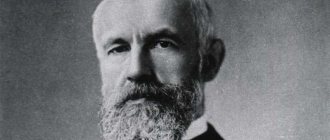In world psychological science, there are many theories and concepts of emotions. The terms affect, emotions, feelings, sensations for a particular author mean their understanding [11]. In this article we will briefly consider three theories of emotions that preceded the emergence of the theory of emotions by A.Yu. Afanasyev: theory of emotions by S. L. Rubinstein; Charles Darwin's evolutionary theory of emotions; associative theory of W. Wundt.
Most theories (concepts) of emotions certainly complement each other, despite the fact that scientists argue with each other in approaches, emphases and ideas about emotions. What all authors have in common are three aspects in understanding emotions:
- emotions as a phenomenon, that is, from the point of view of their structure;
- emotions as psychophysical states;
- emotions as a process unfolded over time.
The approach of A.Yu. is original. Afanasyev in the book “Syntax of Love” from the point of view of an attempt to synthesize ideas about the emotions of various scientists and create a psychotypology consisting of 24 personality types. Generalization (severity) of emotions in A.Yu. Afanasyev is presented in 4 variants (1 Emotion, 2 Emotion, 3 Emotion and 4 Emotion) and in relationship (combination) with corporeality (I - physical according to W. James), will, thinking (logic) [1]. This approach to the study of emotions is fundamentally new and represents the fourth aspect in the understanding of emotions, which can be conventionally called a psychological property of a person. Perhaps in the future there will be a synthesis of the most significant theories of emotions, and one universal one will be discovered that can explain the phenomenon of human emotions; it is possible that a unified classification of emotions will be adopted. In this regard, it can be confidently stated that the original approach of A.Yu. Afanasyev and his method of psychosophy is the first step towards creating a synthetic (universal) theory of emotions.
In the work “Emotions and Feelings” E.P. Ilyin analyzed and systematized the ideas about emotions of domestic and foreign scientists and proposed the following types of theories of emotions that explain the mechanism of their occurrence:
- Charles Darwin's evolutionary theory of emotions;
- associative theory of W. Wundt;
- peripheral theory of W. James - G. Lange;
- theory of W. Cannon - P. Bard;
- psychoanalytic theory of emotions;
- vascular theory of expression of emotions by I. Weinbaum;
- biological theory of emotions by P.K. Anokhin;
- frustration theory of emotions;
- cognitivist theories of emotion;
- information theory of emotions by P. V. Simonov;
- theory of differential emotions by K. Izard [8].
Noteworthy is the systematization and comparison of the views of scientists in lectures on the course “General Psychology” by Moscow State University professor V.V. Petukhov, which he read at the Faculty of Psychology of Moscow State University in 1997-98, and which were recorded as video lectures (they are publicly available on the Internet). V.V. Petukhov dwells on the importance of the views of the philosopher B. Spinoza, emphasizing the fact that it was he who first introduced the term “affect”[12].
Speaking about the main problems of psychological theories of emotions, Professor V.K. Viliunas emphasizes the universal importance of emotions as follows: “By constituting partiality in a person, without which not a single active step is conceivable, emotions clearly reveal their influence in production and in the family, in cognition and art, in pedagogy and clinics, in creativity and mental crises of a person”[3, C.8]. This means that emotions are present in all areas of human life, and they must be carefully studied. However, according to V.K. Vilyunas, Yu.B. Gippenreiter, interest in the study of emotions among scientists is declining due to the complexity of the subject of research itself. And in this regard, L.S. is right. Vygotsky, who wrote: “Spinoza’s problems in an unresolved form await their solution” [5, p. 130]. The appearance at the end of the 20th century of a philosophical and psychological treatise by the Russian literary critic A.Yu. Afanasyev’s “Syntax of Love” made it possible to partially solve the problem of the phenomenon of emotions, which V. Spinoza spoke about.
E.P. Ilyin writes: “Emotions are a psychophysiological phenomenon, therefore the occurrence of a person’s experience can be judged both by the person’s self-report of the state he is experiencing, and by the nature of changes in vegetative indicators (heart rate, blood pressure, respiratory rate, etc.) and psychomotor skills: facial expressions, pantomimics (posture), motor reactions, voice” [8, C. 8.] This connection has long been noticed by different peoples and used for practical purposes. For example, in ancient China, those suspected of committing any illegal act were forced to take a pinch of rice into their mouth. Then, after hearing the accusation, he spat it out. If the rice was dry, it means that the suspect’s mouth was dry from excitement, fear, and he was found guilty. Currently, testing a suspect using a polygraph - a “lie detector” - is based on changes in autonomic reactions during emotiogenic phrases.
The theory of emotions by S. L. Rubinstein
In Russian psychology, one of the most famous theories of emotions is the theory of S. L. Rubinstein. The author explored emotions in their diversity from various points of view, in connection with needs, motivations, will, etc. In his research, S.L. Rubinstein relied on the theory of emotions of R. Descartes, B. Spinoza, I. Pavlov, W. James and many other domestic and foreign scientists. First of all, S.L. Rubinstein was very interested in questions related to the nature and functions of emotions. He believed that emotions are easier to identify when needs are not met. He wrote that the initial moment that determines the nature and function of human emotions is that a connection is established between the course of external events and the course of human activity aimed at satisfying needs in connection with these events. The nature of emotions is closely related to the course of the internal processes of his body, capturing the basic vital functions on which the life of the organism as a whole depends. Thus, S. L. Rubinstein wrote that emotions are a subjective form of existence of motivation (needs): “Acting as a manifestation of a need, as a specific mental form of its existence, emotion expresses the active side of a need... Arising... in the activity of an individual, emotion or needs, experienced in the form of emotions, are at the same time incentives for activity” [10, P.460]. According to S. L. Rubinstein, the motivating role of emotions is as follows: “...Emotion itself contains an attraction, desire, aspiration, directed towards an object or from it, just as an attraction, desire, aspiration is always more or less emotional” [ 10, p.489]. It is important that, according to S.L. Rubinstein, “the question of where the charge of energy comes from in motivation is quite complex. It is impossible to exclude the presence of the energy of emotions in the impulse to action, but it is also hardly possible to consider that emotions themselves cause an impulse to action [10, p. 491].
Feeling (according to S.L. Rubinstein) is a person’s attitude to the world, to what he experiences and does in the form of direct experience.
Signs of emotions (according to S.L. Rubinstein):
- express the state of the subject and his relationship to the object;
- differ in polarity, i.e. have a positive or negative sign;
S.L. Rubinstein distinguishes three levels of the emotional sphere.
- Level of organic emotional-affective sensitivity. This includes elementary so-called physical feelings - pleasures, displeasures, associated primarily with organic needs.
- Objective feelings corresponding to objective perception and objective action. There is a higher level of awareness of the feeling here. Conscious experience of a person’s relationship to the world. It is possible to divide these feelings into intellectual, aesthetic, and moral.
- Generalized feelings: sense of humor, irony, sense of the sublime, tragic. They express general, more or less stable worldviews of the individual.
In addition to the feelings of S.L. Rubinstein describes affects and passions, which are different from feelings, but related to them.
Affect according to S.L. Rubinstein is nothing more than a strongly expressed emotion, a rapidly and violently occurring emotional process of an explosive nature, which can provide release in action. The scientist assumed that the affective state is expressed in inhibition of conscious activity.
S. L. Rubinstein also noted the need to connect thinking with the affective sphere of a person. “Mental processes, taken in their specific integrity, are not only cognitive processes, but also affective, emotional and volitional processes. They express not only knowledge about phenomena, but also attitude towards them” [9, C. 264]. In his work “Problems of General Psychology” he sharpens this issue even more: “The point... is not only that emotion is in unity and interrelation with the intellect or thinking with emotion, but that thinking itself, as a real mental process, is itself is the unity of the intellectual and emotional, and emotion is the unity of the emotional and intellectual” [9, pp. 97-98]. Even in the first half of the 20th century, they talked about affects as emotional reactions aimed at defusing the emotional arousal that had arisen. For example, S. L. Rubinstein used the terms “emotional” and “affective” as equivalent: “... the three-fold division of mental phenomena into intellectual, emotional and volitional cannot be maintained. The primary, main thing is the two-part division of mental processes into intellectual and affective...” [9, P.269].
Passion by S.L. Rubinstein - a strong, persistent, long-lasting feeling that, having taken root in a person, captures him and owns him. Passion is always expressed in concentration, concentration of thoughts and forces, their focus on a single goal. In passion, the volitional moment of aspiration is clearly expressed; passion is a unity of emotional and volitional moments; aspirations in him prevail over feelings.
Mood is the general emotional state of a person. “The mood is not objective, but personal (he is happy!), it is an diffuse general state. An unconscious, emotional assessment by a person of how circumstances are currently shaping up for her does not know the reason,” the scientist emphasized when studying mood [9, P.270].
Thus, the basis of the theory of emotions by S.L. Rubinstein is that the author explored emotions in their diversity from various points of view, in connection with needs, motivation, will, intellect and thinking. Through the prism of psychosophy A.Yu. Afanasyev, it can be assumed that S.L. Rubinstein came close to the relationship of leading mental functions.
James-Lange theory
This theory is called peripheral. It was discovered by two scientists almost at the same time, which is why it received such a double name. Its essence lies in the fact that the emergence of any emotion is preceded by a physiological reaction of the body. And the cause-and-effect relationship we are accustomed to is of a slightly different order. That is, according to the theory, we feel fear because we tremble, and we do not tremble because we feel fear. And not vice versa. The mechanism for the emergence of emotion begins with a physiological reaction to an external stimulus, and only then follows a certain emotional reaction.
Evolutionary theory of emotions by Charles Darwin.
Charles Darwin published the book “The Expression of Emotions in Man and Animals” in 1872, in which he showed the evolutionary path of development of emotions and substantiated the origin of their physiological manifestations. He believed that emotions are either useful or represent only remnants (rudiments) of various expedient reactions that were developed during the process of evolution in the struggle for existence. He reasoned approximately as follows: an angry person blushes, breathes heavily and clenches his fists because in its primitive history, any anger led people to a fight, and it required vigorous muscle contractions and, consequently, increased breathing and blood circulation, ensuring muscle work. C. Darwin explained sweating of hands in fear, for example, by the fact that in the ape-like ancestors of humans, this reaction in case of danger made it easier to grab tree branches.
Thus, Darwin proved that in the development and manifestation of emotions there is no impassable gap between humans and animals. In particular, he showed that anthropoids and children born blind have much in common in the external expression of emotions. The similarity of the mechanisms of emotions and their manifestations in humans and animals, according to Charles Darwin, does not mean their complete identity. Charles Darwin attached great importance to the external expression of emotions, emphasizing their unity. He believed that “emotions hardly exist if the body remains passive. Expression is expressed through speech, facial expression, pantomimic, gestural means, as well as through attention to one’s appearance” [6, P.56].
Darwin's concept was purely biological. As E.P. writes Ilyin, she “did not reveal the origin of specifically human emotions and feelings that bear the imprint of human social nature” [8, P.36].
Differential theory
American psychologist K. Izard considered emotions as a complex system. Every emotional state contains three elements:
- physiological;
- expressive;
- subjective.
Each emotional experience corresponds to a certain combination of physiological manifestations, and by observing external signs, we can judge what the people around us may be feeling. There are basic emotions that all people express in approximately the same way, although depending on their nationality, the intensity and characteristics of the expression may vary.
The scientist identified 10 fundamental emotions, and in order to show the degree of expression and intensity he indicated pairs of words as follows:
- pleasure - joy;
- astonishment;
- interest - excitement;
- anger-rage;
- contempt - disdain;
- grief - suffering;
- disgust - disgust;
- fear - horror;
- shame - shyness;
- guilt - repentance.
He also noted that a large number of emotions are presented in a mixed form, calling them dyads (for example, interest-pleasure) and triads (for example, disgust-fear-contempt).
Wilhelm Wundt's association theory of emotions
Among foreign theories of emotions, the associative theory of Wilhelm Wundt is well known [4]. V. Wundt's views on emotions do not fit into the framework of a specific direction; they are diverse. On the one hand, he thought that ideas influence feelings, and on the other hand, he believed that emotions are, first of all, internal changes, characterized by the direct influence of feelings on the course of ideas. V. Wundt considers bodily reactions only as a consequence of feelings. According to Wundt, facial expressions arose initially in connection with elementary sensations, as a reflection of the emotional tone of sensations; higher, more complex feelings (emotions) developed later [4]. E.P. Ilyin analyzes the views of V. Wundt from the point of view of associations, when some kind of emotion arises in a person’s mind, it evokes by association a corresponding lower feeling or sensation that is similar in content. It is this that causes those facial movements that correspond to the emotional tone of sensations. The following striking example is given: facial expressions of contempt (pushing the lower lip forward) are similar to the movement when a person spits out something unpleasant that has fallen into his mouth. Many scientists, artists, and writers have written about facial expressions of emotions. The human face is capable of expressing various emotional shades. This is described in detail in the book by A.Yu. Afanasyev “Syntax of love” in the section devoted to emotions. It is also known that Leonardo da Vinci said that eyebrows and mouth change differently for different reasons for crying, and Lev Nikolaevich Tolstoy described 85 shades of eye expression and 97 shades of a smile, revealing a person’s emotional state (restrained, tense, artificial, sad , contemptuous, sardonic, joyful, sincere, etc.) [1, P.44].
Thus, the emergence of psychosophy by A.Yu. Afanasyev and his interpretation of the psychological phenomenon of emotions from the point of view of systematicity and integrity using the methodological principle of Occam's Razor made it possible to partially solve the problems of emotions in psychology. The challenge has been issued! Who will go next?
Facial feedback theory
S. Tomkins developed the theory of facial feedback based on the scientific research of W. James. According to this theory, every emotion is automatically reflected in a certain way on a person’s face. Thus, when exposed to a stimulus, a physiological reaction occurs and those facial muscles that correspond to the experienced emotion are tensed. As in the peripheral theory of emotions, the bodily reaction here is primary and one can judge the emotion that has arisen by facial expression. That is, for example, if a girl smiles, then she is happy and joyful, and if she frowns, then she probably experiences sadness or another negative emotion. Thus, changes in the facial muscles give the brain a kind of hint about what emotion is taking place. Various experiments were carried out, on the basis of which it was revealed that when reacting to the same stimuli, most people experience similar facial expressions.
List of used literature
- Afanasyev A.Yu. Syntax of love / A.Yu. Afanasiev. – M.: Izvestia, 2013.
- Vilyunas V.K. Psychological mechanisms of human motivation./ V.K. Viliunas. - M.: Moscow State University Publishing House, 1986.
- Vilyunas V.K. Basic problems of the psychological theory of emotions / V.K. Viliunas. – M.: Psychology of emotions. Texts, 1984.
- Wundt V. Essays on psychology. - M., 1912.
- Vygotsky L. S. Spinoza and his teaching about emotions in the light of modern psychoneurology // Questions of Philosophy. - 1970. - No. 6.
- Darwin Ch. On the expression of emotions in humans and animals / Ch. Darwin. – St. Petersburg: Peter, 2001
- James W. Psychology / W. James - M.: Nauka, 1991
- Ilyin E.P. Emotions and feelings / E.P. Ilyin. - St. Petersburg: 2001.
- Rubinstein S. L Being and consciousness. About the place of the psyche in the universal interconnection of phenomena of the material world. - M., 1957.
- Rubinstein S. L Fundamentals of general psychology. - M., 1946 (reprint - St. Petersburg: Peter, 1999).
- Ekman P. Psychology of emotions. I know how you feel /P. Ekman - St. Petersburg: Peter, 2012.
- Lectures (video) on the course “General Psychology” by Moscow State University professor V.V. Petukhova.
Need-information theory
This theory was proposed by the domestic physiologist P.V. Simonov. In his understanding, emotions are determined by an actual need and how a person assesses the possibility of satisfying it. The evaluation process occurs automatically, a person analyzes certain information available to him in a habitual, unconscious way, and it quickly becomes clear to him what the likelihood is that his need can be satisfied.
The analysis takes into account:
- how strong and important a certain need is for a person;
- what will be required to satisfy it, that is, what efforts will need to be made;
- whether a person has enough resources to take actions to achieve a goal.
If such an involuntary assessment goes smoothly and its result is positive, emotions, as a rule, do not appear and the need is naturally satisfied. If it happens differently and, for example, a person does not have enough resources to satisfy his need, then a negative emotion arises and then he has to look for other solutions. And if the goal turns out to be easily achievable, then a positive emotion occurs.










